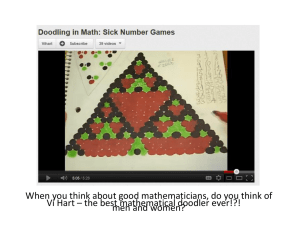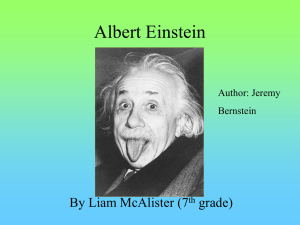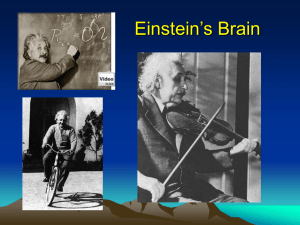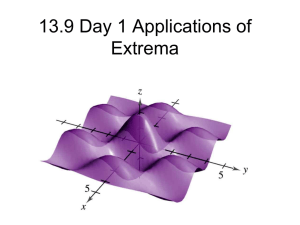Mathematics from 1500 to the Present Day
advertisement
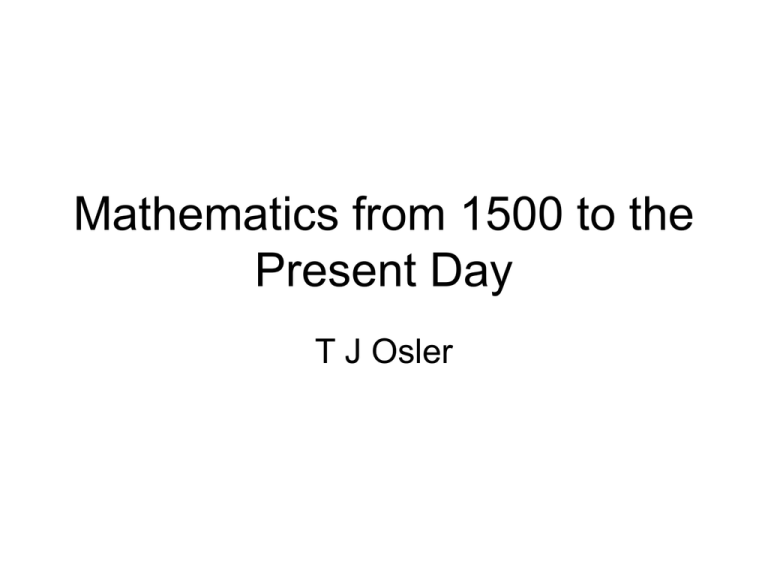
Mathematics from 1500 to the Present Day T J Osler François Viète (1540 - February 13, 1603), generally known as Franciscus Vieta, was a French mathematician. Vieta’s product of nested radicals (1592) was the first formula for Pi 2 1 1 1 1 2 2 2 2 1 1 1 1 1 2 2 2 2 2 John Wallis (November 23, 1616 - October 28, 1703) was an Englishmathematician who is given partial credit for the development of modern calculus . Wallis product for Pi - 1656 1 3 3 5 5 7 7 9 2 2 4 4 66 88 2 William Brouncker, 2nd Viscount Brouncker, FRS (1620 . – 5 April 1684) was anEnglish mathematician Brouncker’s continued fraction for Pi - 1656 4 2 1 1 3 2 2 2 5 2 2 7 2 2 René Descartes (31 March 1596 – 11 February 1650), was a French philosopher,mathematician, scientist, and writer. Invented Analytic Geometry • Isaac Newton 1642 -1727 • Robert Hooke 1635 – 1703 • Edmund Halley 1656 – 1742 • Gottfried Leibniz 1646 - 1716 George Berkeley (12 March 1685 – 14 January 1753), also known as Bishop Berkeley, was an Irish philosopher . • Berkley found flaws in the foundations of Newton’s calculus. • Newton spoke of “infinitesimals” numbers not zero, but smaller than any assigned quantity. • These difficulties would not be removed until the 1800s Leonhard Paul Euler (pronounced [ˈɔʏlɐ] in German, in English;15 April 1707 – 18 September 1783) was a pioneering Swiss mathematician andphysicist who spent most of his life in Russia and Germany. Zeta Function 1 ( z) z n 1 n 1 1 1 z z z 1 2 3 1 1 1 1 (2) 2 2 2 2 1 2 3 4 1 1 1 1 (4) 4 4 4 4 1 2 3 4 (2k ) (1) k 1 2 6 4 90 2 B2 k 2(2k )! 2k 2k Calculus of Variations Stamp of the former German Democratic Republic honoring Euler on the 200th anniversary of his death. In the middle, it shows his polyhedral formula V − E + F = 2. • Euler wrote some 866 Books, papers and letters of ground breaking mathematical content • He is the most prolific mathematician of all time • Even though he went blind in his later years, his mathematical productivity increased Joseph-Louis Lagrange, born Giuseppe Lodovico Lagrangia (25 January 1736 –10 April 1813) was an Italian mathematician and astronomer, who lived most of his life in Prussia and France, making significant contributions to all fields of analysis, tonumber theory, and to classical and celestial mechanics. • Lagrangian mechanics • Between 1772 and 1788, Lagrange reformulated Classical/Newtonian mechanics to simplify formulas and ease calculations. These mechanics are called Lagrangian mechanics. • Worked on Celestial Mechanics and the solution of algebraic equations Pierre-Simon, marquis de Laplace (23 March 1749 – 5 March 1827) was a French mathematician and astronomer whose work was pivotal to the development of mathematical astronomy and statistics. • Laplace worked on Celestial Mechanics • Mécanique Céleste • Tried to prove that the solar system was stable Johann Carl Friedrich Gauss. (30 April 1777 – 23 February 1855) “The Prince of Mathematicians” • As a teenager, Gauss showed how to construct a regular 17 gon • First major geometric construction in 2000 years • • Prime numbers of this form are also known as the Fermat primes • • Gauss proved that a regular n-gon could be geometrically constructed if the number of sides were a product of distinct Fermat Primes times a power of two Titus Bode Law • To find the mean distances of the planets, beginning with the following simple sequence of numbers: • 0 3 6 12 24 48 96 192 384 • With the exception of the first two, the others are simple twice the value of the preceding number. • Add 4 to each number: • 4 7 10 16 28 52 100 196 388 • Then divide by 10: • 0.4 0.7 1.0 1.6 2.8 5.2 10.0 19.6 38.8 • In 1800 Astronomers begin the search for the planet between Mars and Jupiter Discovery of Asteroid Ceres Makes Gauss Famous • 1801 Italian astronomer Piazzi observes a moving celestial object for 41 days before it disappears behind the sun • The newly-discovered planet had been lost • Laplace declared that the new planet was lost because its orbit could not be calculated from so little data • 24 year old Gauss discovered a method for computing the planet's orbit using only three of the original observations and successfully predicted where Ceres might be found. • The prediction catapulted him to worldwide acclaim Jean Baptiste Joseph Fourier (March 21, 1768 – May 16, 1830) was a French mathematician and physicist best known for initiating the investigation of Fourier series and their application to problems of heat flow. • Let f(x) have period 2L f(x+2L)=f(x) a0 nx nx f ( x) an cos bn sin 2 n1 L L 1 an L c L 1 bn L f ( x) cos c c L c f ( x)sin nx L dx nx L dx Example Fourier Series 1 1 f ( x) 1 for 0 x for x 2 4 sin x sin 3x sin 5 x f ( x) 1 3 5 Fourier Series Example 2 x f ( x) 2 x for 0 x for x 2 4 sin x sin 3x sin 5 x f ( x) 2 2 2 2 1 3 5 • Fourier Series challenged the intuition of the greatest mathematicians • How could a sum of such smooth functions as sine and cosine represent discontinuous functions? • Later Carl Weierstrass showed a Fourier Series that was continuous everywhere, but differentiable nowhere! Augustin Louis Cauchy (21 August 1789 – 23 May 1857; was a French mathematician. • Cauchy finally provided the Calculus with a rigorous foundation • He introduced the epsilon – n and epsilon – delta definitions of limit. • From these we can rigorously define continuous functions and differentiable functions • The meat of our Real Analysis course Évariste Galois October 25, 1811 – May 31, 1832) was a French mathematician born in Bourg-la-Reine. • While still in his teens, he was able to determine a necessary and sufficient condition for a polynomial to be solvable by radicals, thereby solving a long-standing problem. • He died fighting a duel over a woman at age 21 • Georg Friedrich Bernhard Riemann September 17, 1826 – July 20, 1866) was an extremely influential Germanmathematician who made important contributions to analysis and differential geometry, some of them paving the way for the later development of general relativity. Riemann Riemann Hypothesis – Most famous unsolved problem in mathematics The non-trivial zeros of the zeta function lie on the line x = ½ in the complex plane • Jules Henri Poincaré (29 April 1854 – 17 July 1912) was a French mathematician and theoretical physicist, and a philosopher of science. Poincaré is often described as a polymath, and in mathematics as The Last Universalist, since he excelled in all fields of the discipline as it existed during his lifetime. Jules Henri Poincaré • In 1887 he won Oscar II, King of Sweden's mathematical competition for a resolution of the three-body problem concerning the free motion of multiple orbiting bodies. • The two body problem was solved analytically by Newton, and the solution is Kepler’s equations of planetary motion. • The three body problem has never been solve analytically, although approximate computer solutions are easy to generate. • Albert Einstein 14 March 1879 – 18 April 1955) was a German-born theoretical physicist. He is best known for his theory of relativity and specifically mass–energy equivalence, expressed by the equation E = mc2. Einstein received the 1921 Nobel Prize in Physics "for his services to Theoretical Physics, and especially for his discovery of the law of the photoelectric effect.” • 1879: Albert Einstein is born to Hermann Einstein • 1889: At age 10, Albert sets into a program of self education and reads as much about science as he can. • 1896: Albert graduates from high school at the age of 17 and enrolls at the ETH (the Federal Polytechnic) in Zurich. • 1898: Albert falls in love with Mileva Maric, a Hungarian classmate at the ETH. • 1900: Albert graduates from the ETH. • 1902 Mileva gives birth to a daughter whom they put up for adoption • 1903: Albert and Mileva marry in January • 1904: Mileva gives birth to their first son, Hans Albert. • 1905: "Annus Mirabilis" -- Einstein's "Miracle Year": his Special Theory of Relativity is born. • June 30th, Einstein, submits his paper, "On the Electrodynamics of Moving Bodies" to the leading German physics journal. At age 26, he applies his theory to mass and energy and formulates the equation e=mc^2. • • 1907: Einstein begins applying the laws of gravity to his Special Theory of Relativity. • 1910: Son Eduard is born. • 1913: Einstein works on his new Theory of Gravity. • 1914: The divorce prodedings begin. • 1915: Einstein completes the General Theory of Relativity. • 1919: Albert marries his cousin Elsa. • May 29, a solar eclipse proves Einstein's General Theory of Relativity works. One of the 1919 eclipse photographs taken during Arthur Stanley Eddington's expedition, which confirmed Einstein's predictions of the gravitational bending of light. • 1922: Is awarded the Nobel Prize in physics for 1921. • 1932: Einstein is 53 and at the height of his fame. Identified as a Jew, he begins to feel the heat of Nazi Germany. • 1933: Albert and Elsa set sail for the United States. They settle in Princeton, New Jersey where he assumes a post at the Institute for Advanced Study. Einstein’s House in Princeton NJ • 1936: Elsa dies after a brief illness. • 1939: World War II begins. Einstein writes a famous letter to President Franklin D. Roosevelt warning of the possibility of Germany's building an atomic bomb and urging nuclear research. • 1955: Einstein dies of heart failure on April 16. G. H. (Godfrey Harold) Hardy FRS (February 7, 1877 Cranleigh, Surrey, England [1] –December 1, 1947 Cambridge, Cambridgeshire, England [2]) was a prominent Englishmathematician, known for his achievements in number theory and mathematical analysis. • Non-mathematicians usually know him for A Mathematician's Apology, his essay from 1940 on the aesthetics of mathematics. • The apology is often considered one of the best insights into the mind of a working mathematician written for the layman. • His relationship as mentor, from 1914 onwards, of the Indian mathematician Srinivasa Ramanujan has become celebrated. • Hardy almost immediately recognized Ramanujan's extraordinary albeit untutored brilliance, and Hardy and Ramanujan became close collaborators. Srīnivāsa Rāmānujan Iyengar FRS, better known as Srinivasa Ramanujan (22 December 1887 – 26 April 1920) was a legendary Indianmathematician,[1] who, with almost no formal training in pure mathematics, made substantial contributions to mathematical analysis, number theory, infinite series andcontinued fractions. Ramanujan’s Home • John von Neumann (December 28, 1903 – February 8, 1957) was a Hungarian American[1] mathematician • Made major contributions to a vast range of fields,[2] including set theory,functional analysis, quantum mechanics, ergodic theory, continuous geometry,economics and game theory, computer science, numerical analysis,hydrodynamics (of explosions), and statistics, as well as many other mathematical fields. He is generally regarded as one of the foremost mathematicians of the 20th century.[1] Benoît B. Mandelbrot[1] (born 20 November 1924) is a French mathematician, best known as the father of fractal geometry Mandelbrot speaking at the École Polytechnique in 2006, during the ceremony when he was made an officer of the Legion of Honour. Thomas J Osler 1940-?

